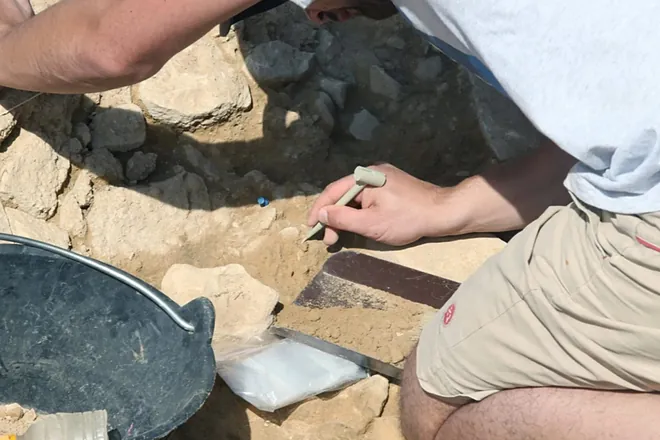History has a way of surprising us. Just when we think the past has been fully mapped, a discovery arrives that flips the script. Secrets of Ancient Egypt revealed this month may represent one of those turning points. Archaeologists in El Husseiniya, north of Cairo, uncovered a new inscription on the so-called Hill of the Pharaohs.
What they found is not merely another broken tablet or ceremonial carving. It is a new version of the Canopus Decree—a text first issued in 238 BCE during the reign of Pharaoh Ptolemy III. This decree has long been central to understanding Egypt’s politics, religion, and even its calendar. Now, with a seventh version in hand, Egyptologists suggest our picture of Ancient Egypt may need to be redrawn.

The Discovery on the Hill of the Pharaohs
On September 9, 2025, Egypt’s Ministry of Tourism and Antiquities revealed the find: a sandstone block measuring about 1.2 meters long. At the top sits a winged solar disk flanked by two royal cobras, unmistakable symbols of divine kingship. Below that, instead of the expected trilingual text, lies something unusual.
The inscription is only in hieroglyphs—with a blank space beneath, where scholars would normally expect a demotic script translation. Egyptologist Stefan Pfeiffer of the University of Halle explained that this suggests the piece may be incomplete, but it could also represent a deliberate choice to emphasize hieroglyphs as the sacred language of gods and kings.
Either way, this sandstone is not just another copy. It is a variant, and in the world of philology—where every letter, spacing, and omission matters—variants are gold.
Why the Canopus Decree Matters
To appreciate why this new version is such a big deal, it helps to understand what the Canopus Decree is and why it became a cornerstone of Egyptology.
Political Propaganda in Stone
The decree was issued by Egyptian priests in honor of Pharaoh Ptolemy III Euergetes, celebrating his military campaigns and religious benefactions. It also elevated his daughter, Princess Berenice, to divine status after her untimely death, ensuring her memory lived through official rituals.
A Calendar for the Ages
Perhaps the decree’s most famous contribution is its reform of the Egyptian calendar. It introduced an additional day every four years—a leap year system remarkably similar to the Julian calendar later adopted by Rome and still reflected in the Gregorian calendar we use today. In short, part of our modern sense of time traces back to this very decree.
Deciphering Egypt’s Languages
The Canopus Decree, like the Rosetta Stone, exists in multiple scripts. This multilingual approach was crucial for 19th-century scholars trying to decode ancient Egyptian. Each new copy sharpens translations, fills gaps, and helps confirm interpretations.
What Makes This Version Unique?
The inscription found on the Hill of the Pharaohs is different from the six known copies. Here’s a quick comparison:
| Feature | Previously Known Versions | New Hill of the Pharaohs Version |
|---|---|---|
| Scripts Used | Hieroglyphic, Demotic, Greek | Hieroglyphic only (with blank demotic space) |
| Material | Various stelae (limestone, granite) | Sandstone block |
| Condition | Fragmentary in some cases | Good preservation, clear hieroglyphs |
| Distinctive Feature | Multilingual clarity | Possible unfinished or censored edition |
This deviation raises tantalizing questions:
- Was the demotic section never carved, perhaps abandoned mid-work?
- Was it an intentional omission to give hieroglyphs dominance?
- Could this represent a local adaptation, reflecting how provincial temples engaged with royal decrees?
Each possibility reframes our understanding of Ptolemaic Egypt as a living, contested society rather than a monolithic culture.
Secrets of Ancient Egypt Revealed Through Variants
The real secret here isn’t that archaeologists uncovered “new history” as much as they uncovered new nuance. Variants in ancient texts open windows into how ideas were transmitted, edited, or even censored.
For example, leaving out the demotic script might suggest:
- A priesthood eager to highlight sacred tradition over the language of everyday Egyptians.
- A regional scribe’s error, reflecting imperfect communication across Egypt’s vast territories.
- A politically motivated omission, downplaying Greek influence in a Greek-ruled land.
This isn’t just about a missing translation—it’s about power, identity, and cultural negotiation.
What the Find Tells Us About Ancient Egypt Today
The sandstone inscription adds weight to the idea that Ancient Egypt was not static but constantly adapting. A few key takeaways:
- Priestly Power: The decree shows how the priesthood shaped politics, using religion to honor rulers and secure their own influence.
- Cosmopolitan Egypt: With Greek, Egyptian, and demotic traditions intertwined, Egypt was a multicultural empire long before globalization.
- Living Texts: The Canopus Decree wasn’t just copied verbatim. Its variants prove that each version served a context, whether local politics, religious emphasis, or royal propaganda.
How the Canopus Decree Shapes Modern History
The leap year system introduced in the decree may be its most far-reaching legacy. To put it plainly, when you check your calendar today, you’re looking at a distant echo of Ptolemy III’s Egypt.
But beyond that, each discovery like this one deepens humanity’s ability to connect dots across time:
- Language: It improves translations of Egyptian hieroglyphs, demotic script, and Greek.
- Chronology: It helps historians align Egyptian events with global history.
- Cultural Studies: It reveals how societies managed diversity, propaganda, and ritual.
Why “Secrets of Ancient Egypt Revealed” Always Captures Imagination
Headlines promising “secrets revealed” aren’t just clickbait—they reflect a real truth. Ancient Egypt continues to surprise us because:
- Much remains buried beneath sands and cities.
- Even small finds, like this sandstone, can reshape interpretation.
- Egypt’s symbolic language of gods, kings, and rituals still resonates in popular imagination.
This discovery reminds us that history isn’t fixed—it’s a living puzzle where every new piece matters.
A Turning Point in Understanding Ancient Egypt
The new inscription on the Hill of the Pharaohs doesn’t topple everything we know about Ancient Egypt, but it nudges the narrative in fascinating directions. A missing demotic text is not just a blank space—it’s a question mark carved in stone, forcing us to rethink literacy, power, and cultural negotiation in one of the world’s greatest civilizations.
In a time when discoveries are often sensationalized, the true wonder lies not in rewriting history overnight, but in appreciating how each find deepens our understanding of a complex, living past. The secrets of Ancient Egypt revealed by this sandstone are subtle yet profound: that Egypt was diverse, contested, adaptive, and still has more to teach us with every grain of sand uncovered.







